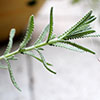Basil
 Basil is a great addition to any summer bed or pot. Most varieties grow to about 18 inches.
Basil is a great addition to any summer bed or pot. Most varieties grow to about 18 inches.
Tip: Basil does not like the cold. If you plan to start your herb garden outside, do not plant until the threat of frost has passed.
How to use: Basil should be ready to add robust flavor to pasta, pizza, salads, and meat dishes about six weeks after you sow seeds. Chop leaves or use them whole.
Chives
 Chives are wonderfully versatile: they do well in outdoor pots or beds, or inside near a windowsill. These plants do well in full sun or partial sun.
Chives are wonderfully versatile: they do well in outdoor pots or beds, or inside near a windowsill. These plants do well in full sun or partial sun.
Tip: After plants flower, trim them back to encourage new growth.
How to use: Snip chive blossoms below the flower and cut leaves just above soil level. Chop chives to add a subtle onion flavor to various dishes.
Dill
 This is a yellow herb that is easy to grow in dry, sunny areas. Unless you harvest all the flowers before they mature, you will find that dill self seeds to reappear every year.
This is a yellow herb that is easy to grow in dry, sunny areas. Unless you harvest all the flowers before they mature, you will find that dill self seeds to reappear every year.
Tip: To be sure you have a constant supply of dill on hand, sow seeds every four weeks during the growing season.
How to use: Dill helps to put a tangy twist on soups, eggs, potatoes and the seeds are great to put in homemade pickles or stews.
Lavender
 Lavender is a calming herb. It has a soothing aroma and serene blossoms. It thrives in the heat but does not care for excessive humidity or waterlogged soil.
Lavender is a calming herb. It has a soothing aroma and serene blossoms. It thrives in the heat but does not care for excessive humidity or waterlogged soil.
Tip: Be sure not to over water this plant. You may want to keep it inside or plant early in the spring in North Central Florida due to excessive summer humidity.
How to use: Not only can you use this herb in lotions and detergents, but also to add more flavor to teas and jellies.
Mint
 Mint is the strongest, most resilient and easy to grow in just about any space. Mint's refreshing aroma is strongest when leaves are cut or bruised.
Mint is the strongest, most resilient and easy to grow in just about any space. Mint's refreshing aroma is strongest when leaves are cut or bruised.
Tip: Since mint is very strong and resilient,it is also very dominant. You may want to keep this one in a pot where you control its growth.
How to use: Mint adds cool flavors to beverages, desserts, vegetables and meat dishes.
Oregano
 This herb grows well even in poor soil, and you can put in a bed or in a window container as part of an in-house living spice rack.
This herb grows well even in poor soil, and you can put in a bed or in a window container as part of an in-house living spice rack.
Tip: Pinch flowers from the stems to promote healthier growing. Some say that the flavor is lost after the plant blooms so be sure to pick leaves before the buds open.
How to use: Oregano is an Italian favorite! It is great to use on pizza, pasta, grilled meats and seafood!
Rosemary
 Rosemary prefers a hot, dry growing environment. In warm winter climates it can grow outside all year-round. For North Central Florida, the Garden Gator suggests brining it inside during months wear you expect frost.
Rosemary prefers a hot, dry growing environment. In warm winter climates it can grow outside all year-round. For North Central Florida, the Garden Gator suggests brining it inside during months wear you expect frost.
Tip: Since Rosemary likes to be dry, you should surround the plant with gravel or small stones to ensure it does not become too wet.
How to use: You can use Rosemary whole or crushed to bring hearty zesty flavor to pork, pasta, or rice.
Sage
 Sage sprouts lovely flowers. It can sometimes be slow to start from seed, so consider sowing indoors a bit early and then transplanting outside.
Sage sprouts lovely flowers. It can sometimes be slow to start from seed, so consider sowing indoors a bit early and then transplanting outside.
Tip: After you let Sage bloom, cut back only to beneath where the buds formed. If you cut its woody stem, you might kill the plant.
How to use: Fresh or dried Sage adds bitterness to egg, cheese and veggies. Rub Sage into red meats or poultry to add a new dimension of flavor
Thyme
 This herb loves heat and sun. The flavors of Thyme really come out when it grows in well-drained soil, so consider putting gravel or small rocks in the bottom your pots
This herb loves heat and sun. The flavors of Thyme really come out when it grows in well-drained soil, so consider putting gravel or small rocks in the bottom your pots
Tip: After the plants bloom, shear off about a third of the stem.
How to use: Dried Thyme leaves add savory complexity to red meat, poultry, and fish. Its flavor works well with roasted veggies.
References from Better Homes and Gardens
